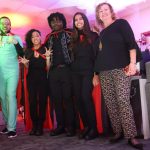
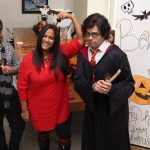
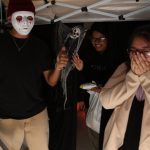
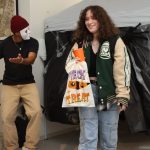
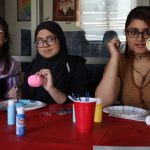
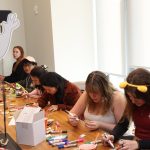
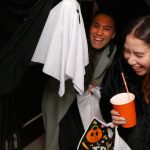
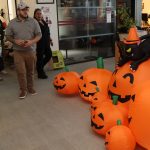
It was a new ambience for the Joseph M. McShane, S.J. Campus Center: eerie music, wolf howls, ghoulish costumes, giant cobwebs, a hallway-size haunted house, laughter mixed with the occasional frightful yelp.
The one flaw in the spookiness? All that natural light flooding in through the huge windows. “The sun is always shining in, it’s beautiful,” said Gabriel Chavarria, a Fordham College at Rose Hill senior passing through the Career Center and Campus Ministry areas.
The Haunted Open House marked a new effort to help fully integrate the McShane Center into University life by enticing students to wander the full length of the second floor, discovering the cavernous hallways and hangout areas along the way—as well as all the offices there to serve them.
The second floor’s Halloween-season transformation highlighted a much larger, permanent transformation of student life brought about by the campus center’s construction, a pillar of the University’s $350 million fundraising campaign, Cura Personalis | For Every Fordham Student.
Enhancing the Entire Student Experience
Construction on the campus center has continued since it opened to students last year. Amid the second-floor Halloween hijinks on Oct. 17, crews were working on the first-floor Marketplace renovation that will produce a vastly better dining experience in another nine months or so.
Unfinished as it is, the McShane Center already feels like students’ home. “This is such a huge resource, and I think it’s a real asset to the University,” said Isabella Guariniello, a junior at Fordham College at Rose Hill who found the haunted house to be “a really cool way to interact with the students and the faculty here.”
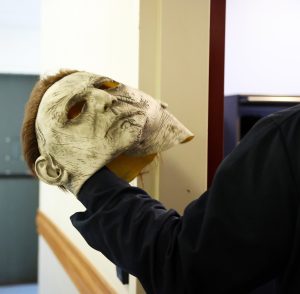
Commuter student Ryan Nole, a Gabelli School of Business junior, appreciates being able to hang out in the campus center between classes. He’s noticed that it’s brought new visibility to student clubs and organizations and provides a kind of social lubricant—“I know if I want to see someone, they’ll probably be here,” he said while checking out the open house. “It definitely fulfills its role as a community space.”
In fact, with so many students gravitating toward the new student lounge and communal spaces on the first floor, “we wanted another way for students to kind of say, ‘Hey, there’s more parts to the building, there’s a whole bunch of stuff up here,’” said Juan Carlos Matos, assistant vice president for student affairs for diversity and inclusion—dressed up for the occasion as “Dr. Acula.”
Students partook of Halloween candy—including the allergy-free kind—and activities like pumpkin painting. All of the second-floor offices got into the act, including Student Services, the Office for Student Involvement, and the Office of Multicultural Affairs.
‘Cathedral-Like’ Light
To be sure, the new campus center has already been boosting the work of second-floor offices including the Career Center, which gained a new suite equipped with 10 interview rooms, event space, and other amenities, including new capabilities to promote career-related events.
The new suite “has truly elevated our office University-wide,” said Annette McLaughlin, director of the Career Center. The 840 career counseling appointments held from July through September represent a 24 percent increase over the same period last year, she noted.
Campus Ministry and the Center for Community Engaged Learning, or CCEL, now share a roomy, inviting suite with floor-to-ceiling windows providing “cathedral-like” light, in the words of Campus Ministry administrator Carol Gibney. It offers plenty of room for students to study or hang out and unwind, making it more likely that they’ll learn about something they want to get involved in, said Amanda Caputo, FCRH ’23, a program manager with Global Outreach. “Students [have]made this their home, in a way,” she said.
By providing generous, dedicated space for CCEL’s meetings with its New York City partner organizations, the facility “demonstrates the University’s commitment to community engagement and experiential learning,” said the center’s executive director, Julie Gafney, Ph.D.
“It helps to show that this is what we mean when we say we’re a Catholic and Jesuit institution,” she said. “We mean that we create spaces that put our mission work first.”
Learn more about the McShane Campus Center renewal and opportunities to give in support of it.
]]>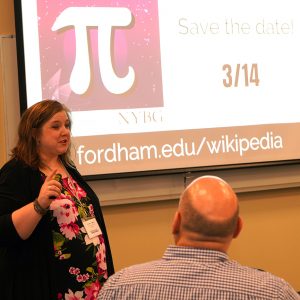
Treglia made these remarks to volunteers gathered at an edit-a-thon focused on women’s history at Fordham’s Lincoln Center campus on March 7. According to Wikipedia, an edit-a-thon is an organized event where people edit and improve a specific topic or type of content. It typically includes basic editing training for new editors. The Fordham edit-a-thon event was hosted by Wikipedia for Educators at Fordham.
The training component was essential, as few of the event’s attendees had a Wikipedia account, though most said they use the site. And most had never edited an entry before.
“Almost every woman I talk to will say, ‘Who am I to edit Wiki?’ and yet men think ‘This is great,’ and just do it,” said Treglia, who said that she derived her tech know-how from the support she got from women along the way.
“I was lucky to have female teachers, female role models who said I could do it, and told me that I have an expertise and I should share it,” she said.
‘Write it; Don’t Cite It’
And share it she has. Treglia has run several edit-a-thons at the University, including one where she partnered with Fordham Libraries to bolster Fordham’s own entry to coincide with the University’s dodransbicentennial. All of the events are meant to encourage students and faculty to share their research and knowledge, particularly faculty who often frown on the site as a somewhat dubious citation resource for students.
“We want to show faculty that it can be used in the classroom as a resource, or as we say, ‘Write it; don’t cite it,’” she said. “Contribute to the largest knowledge base on the planet.”
She noted that assigning contributions to students would also bring more women into the Wikipedia community.
“If students and young people don’t see women on the site, it may not even occur to them that they’re missing,” she said.
Of the nearly two dozen participants, several created new accounts. Another continued to supplement an existing article that she recently introduced about Dorothy Creol, one of the first black women to arrive in New York in 1627. Another made an edit to a page devoted to Lucretia Mott, the 19th-century Quaker abolitionist and women’s rights activist. Meanwhile, a Rose Hill technologist joined the group virtually by adding to an article on feminist geography, which uses feminist theories to study geographic space.
Making Strides Online and Beyond
Several community groups that focus on raising the visibility of women in history participated in the event, including Monumental Women, the nonprofit dedicated to placing the first statue celebrating women’s history in Central Park. It honors Elizabeth Cady Stanton and Susan B. Anthony.
The group is also responsible for a Women’s History Trail that currently encompasses Manhattan, but not yet the outer boroughs. Board President Brenda Berkman said the group is working on fixing that. She noted that the afternoon’s online efforts reflect a need to combat discrepancies in the real world, such as the lack of information on Lucy Burns, the second wave feminist and social justice Catholic. Outside of her gravestone at Holy Cross Cemetery in Brooklyn, there isn’t any other historic marker.
“She was arrested in front of the White House, imprisoned, and force-fed during a hunger strike,” she said. “She’s from Brooklyn, grew up and went to school there, and is buried in there.”
Incidentally, Berkman does have a Wiki page dedicated to her. She was the first woman firefighter hired by the New York Fire Department after she sued the department for discrimination. She was also a first respondent at the World Trade Center on September 11th and retired in 2006 as captain.
Treglia said that a dentist who attended Wednesday’s event found the women in dentistry category lacking, as are entries for women in STEM fields generally. It’s something Treglia hopes to tackle in the group’s next edit-a-thon on March 14, also known as PiDay, for its 3/14 marker. That event will focus on shoring up pages on women scientists.
So far, Guy Robinson, Ph.D., a lecturer in biology, has assigned his class to attend the event. Once again, community participants will be on hand, as will volunteers from Wikimedia NYC, which seeks to support free educational content online.
“Here’s an opportunity for more women to become editors and increase the amount of information on women in the sciences,” said Treglia.
The PiDay event will take place in the O’Hare special collections room at Walsh Library from 4 to 8 p.m., and, of course, pie will be served.
]]>Virginia Roach, Ed.D., dean of GSE, and a vocal proponent of classroom technology, has been working on assembling the digital classroom since she began at Fordham two years ago. It opened last week at the Lincoln Center campus with the help of Fordham IT.
“The lab will allow us to provide real-time instruction without disrupting the ecology of the classroom,” said Roach. “It’s also brings us the opportunity to conduct research.”
The lab contains 360-degree cameras that can scan the entire classroom space. There are six tables with flat-screen monitors, cameras, and several unobtrusive microphones. Known as a collaborative learning lab, the setup allows six groups to work on projects together at the same time.
Meanwhile, in a back room nearby, a flat screen provides the professor with the ability to observe the six groups, either separately or at the same time.
The opportunities are manifold, said Roach. There could be six teachers, each managing a group discussion, or one teacher taking care of all six groups. In each case the teacher(s) could have an earpiece from which the professor could offer instructions without disrupting the ongoing class.
“We talk about teachable moments all the time, but we don’t have those moments with teachers unless we interrupt their classrooms,” said Roach. “This technology turns the prevailing practice on its head. It’s changing the paradigm as to how we’ll be able to coach new teachers.”
When asked whether watching multiple group lessons conducted simultaneously might get confusing, Roach compared the lab to a broadcast newsroom.
“We know is that the human brain is capable of taking in instantaneous feeds and acting on [such activity]at the same time,” she said. “We see this kind of technology deployed in broadcast news every day.”
The classroom itself is multi-functional; tables in the classroom are collapsible and can be replaced with tables more suitable for small children. One such class has already been scheduled.
A former teacher herself, Roach recalled the times when supervisors would physically sit in her class and offer feedback on her performance in a meeting after the class.
“But having faculty in the classroom changed the classroom dynamic,” she said. “The fact that I’m getting a correction after-the-fact compromises the support: all I can do is say, ‘Okay, I’ll try to remember that next time.’”
With new technology, however, Roach said the supervisor can be off-site, in front of the 360-degree cameras, and can offer corrective suggestions in real time. The student teacher can better understand the difference and make an alteration on the spot.
“We should not ignore the potential of this kind of technology,” said Roach. “That’s the importance of a research institution–we should always be exploring the edges of potential.”
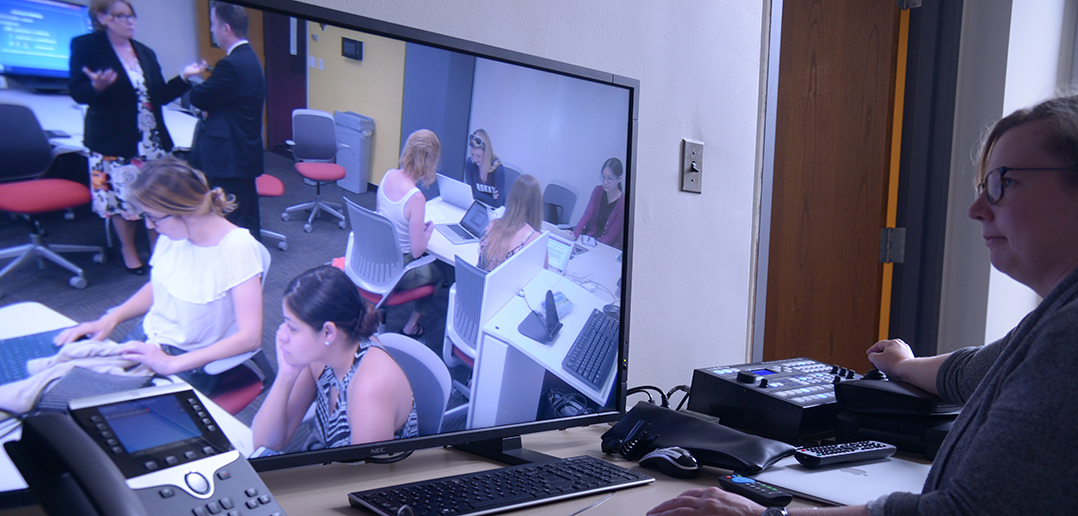
Bill Baker, Ph.D., the Claudio Acquaviva Chair in the Graduate School of Education and director of the Bernard L. Schwartz Center for Media, Public Policy, and Education, presented “The Digital Media Transition: Redefining the American Media Landscape,” in which he called for more digital citizenship.
“It’s one thing to have the technology, but it’s another thing to have the content—and that’s where people like our Fordham faculty come in,” said Baker. “We need to use our minds to say how can we can use technology in the way that . . . not only does the most good, but makes the greatest impact on our society.”A Fragmented Media Landscape
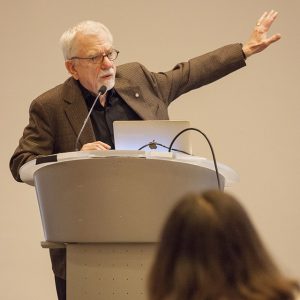
With hundreds of television channels to choose from, and thousands of on-demand options, Baker said the American populace has become fragmented in its choice of news sources. He contextualized today’s landscape by comparing it to a time, a few decades ago, when the CBS Evening News with Walter Cronkite provided Americans with their “water cooler conversations” the next day.
“All of our news came from that trusted source: Cronkite told you stuff you didn’t want to hear but needed to hear,” he said. “But not anymore, that’s one of the reasons why we’re so messed up.”
Today’s choice of news sources allows viewers to select news that fits one’s viewpoint, and “we end up reinforcing our own beliefs, and reinforce our own prejudices,” Baker said.
Moreover, during the last presidential election, Baker shared a disturbing statistic: Of the total Facebook engagement for the top 20 election stories, 8.7 million people got their information from fake news while 7.3 million got their news from mainstream established media.
“More [Americans] believed in the fake than real news,” he said. “We have to figure a way to get more trusted mainstream media.”
He said that, in Germany, a no-frills, 15-minute public news broadcast had a larger audience share than all the American news broadcasts combined. German public media is so trusted that the government pours $10 billion into it every year, as opposed to the $400 million contributed to America’s public broadcasting—which is also under threat by the Trump administration, he said.
Baker added that the administration’s opposition to net neutrality is a threat to smaller players, like pubic media, independents, and new startups.
“They will end up being second-class citizens,” he said.
Fighting Back With Facts, and Wikipedia
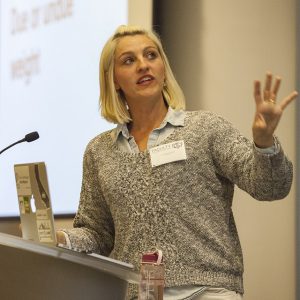
In the afternoon session, Samantha Weald, outreach manager of the Wiki Education Foundation, encouraged faculty to help shore up fact-based knowledge by incorporating Wikipedia projects into their coursework, particularly on the graduate level.
Once viewed as an unreliable source, Wikipedia’s credibility has grown over the years, she said. Yet, the platform has a “gap” problem.
Part of the reason, Weald said, is that 85 percent of Wikipedia’s contributors are young, white males from developed, Western nations—a fact that skews content, she said. For example, only 16.9 percent of Wikipedia’s biographies are about women.
“Information is only as good as how readily available it is,” she said.
College students can fill in those gaps with their original research, while also folding more good-sourced academic material into the free, public, accessible site, she said. According to a Knight Foundation study, Wikipedia is the most-used source of news, with eight billion page views a month.
“Imagine a world in which every human has equal access to knowledge—for free,” she said. “Teaching our students to become digital citizens [can]make that a reality.”
Two Fordham faculty members Harold Takooshian, Ph.D., professor of psychology, and Carla Romney, D.Sc., associate dean for STEM and director of pre-health education
said they’d already used Wikipedia projects in their courses. In his Social Psych course, Takooshian assigned students to come up with 30 biographies of people who were virtually unknown in their field.
“Instead of assigning a paper, I assign[ed]Wikipedia entries,” said Takooshian.
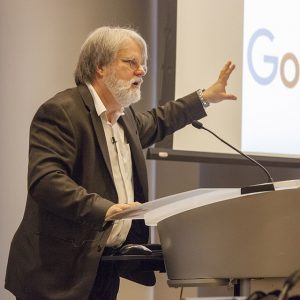
Weald said her foundation works with colleges around the United States and Canada to create Wikipedia-connected courses; to date, some 358 courses are ongoing.
In addition to Baker and Weald, Gardner Campbell, Ph.D., associate professor of English at Virginia Commonwealth University, gave a talk titled “Exercising the Franchise of Digital Citizenship,” while concurrent sessions examined online textbooks, online teaching techniques, digital copyrights, cybersecurity, multimedia, ergonomics, and social media etiquette.
Janet Sassi contributed to this article.
]]>Frank Sirianni, Ph.D., chief information officer and vice president of Fordham IT, accepted the award this March at Agenda17: What’s Next In Digital, a leadership conference held in Jacksonville, Florida.
The conference focused on transforming organizations for the digital world; in other words, how to drive institutions forward in a climate that demands higher education institutions and businesses to anticipate what and who will be using its resources.
The Digital Edge 50 award recognizes Fordham IT’s efforts to move the University’s systems (including Banner, the University’s system of record) and databases to the cloud in the summer of 2016. It was a bold step, because most higher education institutions still rely on local servers and adopting a cloud-based strategy, which is already the norm in finance, healthcare, and other sectors.
For more details about why Fordham IT received the Digital Edge 50 award, read “Fordham IT Receives Digital Edge 50 Innovation Award.”
]]>
This was the finding of Anya Kamenetz, NPR’s lead education blogger and author of DIY U: Edupunks, Edupreneurs, and the Coming Transformation of Higher Education (Chelsea Green Publishing, 2010). On May 12, Kamenetz gave the keynote speech at this year’s Faculty Technology Day, sponsored by Fordham IT.
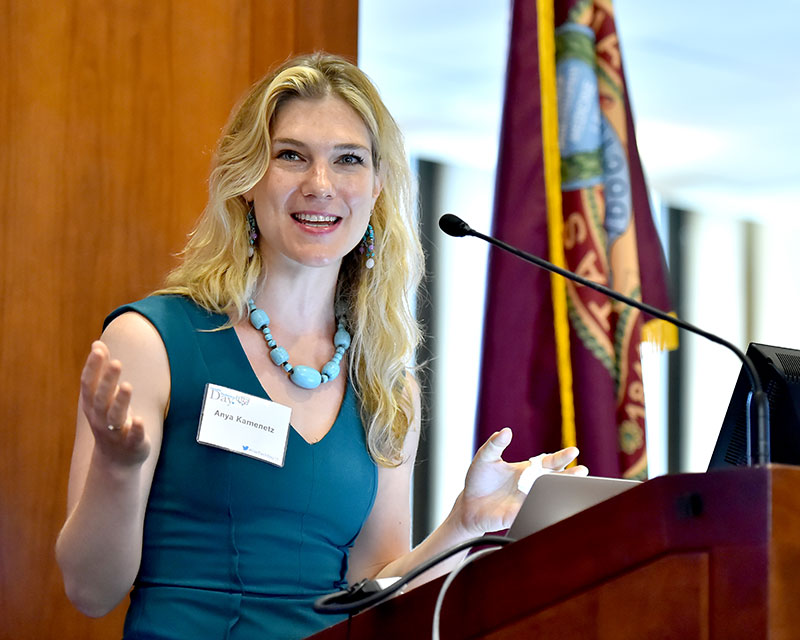
Photo by Dana Maxson
It is well known that colleges and universities are facing major challenges, some of which threaten their very existence. Rising cost is one big issue, Kamenetz said, and access to higher education is enormous.
With these issues in play, the debate about the relevance of higher education, especially the role that colleges and universities will play in an increasingly technocratic society, is the issue that “trumps them all,” she said.
Historically, universities existed to transmit prior knowledge to current generations, Kamenetz said. But today’s schools also need to prepare students for the future. What makes this task difficult, though, is that 65 percent of current students will end up in careers that haven’t even been invented yet.
“The question becomes, ‘What are we doing?’” she said. “If we need to prepare students for jobs that don’t yet exist, then how do we teach them?”
Coming up with an answer to these questions becomes urgent in light of the “race between us and robots,” Kamenetz said, since computers have assumed jobs that humans used to do in the past.
She noted, however, that this “race” isn’t about figuring out how to work better than computers, but rather understanding how to draw on our uniquely human abilities to work well with computer technology.
“The emotional aspects of leadership, teamwork, collaboration, and interpreting knowledge and information to people are something we’ll have to emphasize more and more in this race with computers,” Kamenetz said. “We [may]have a computer program that can read a CT scan, but we need a doctor to sit with a patient and tell them about a poor prognosis.”
Going forward, universities and faculty will remain relevant by fulfilling those “human” roles that computers cannot replace—for instance, providing mentorship, inspiration, and support to students, and helping students to make sense of the plethora of data available in this information age.
“Technology helps us to streamline what we do… But people still need to be in the driver’s seat,” Kamenetz said.
“This forward march of technology is giving us information about the long-term mission of education, which involves things that haven’t changed in a long time,” she continued. “The things we associate with philosophy and the humanities are in fact the most relevant for this generation. This is how our institutions are going to adapt.”
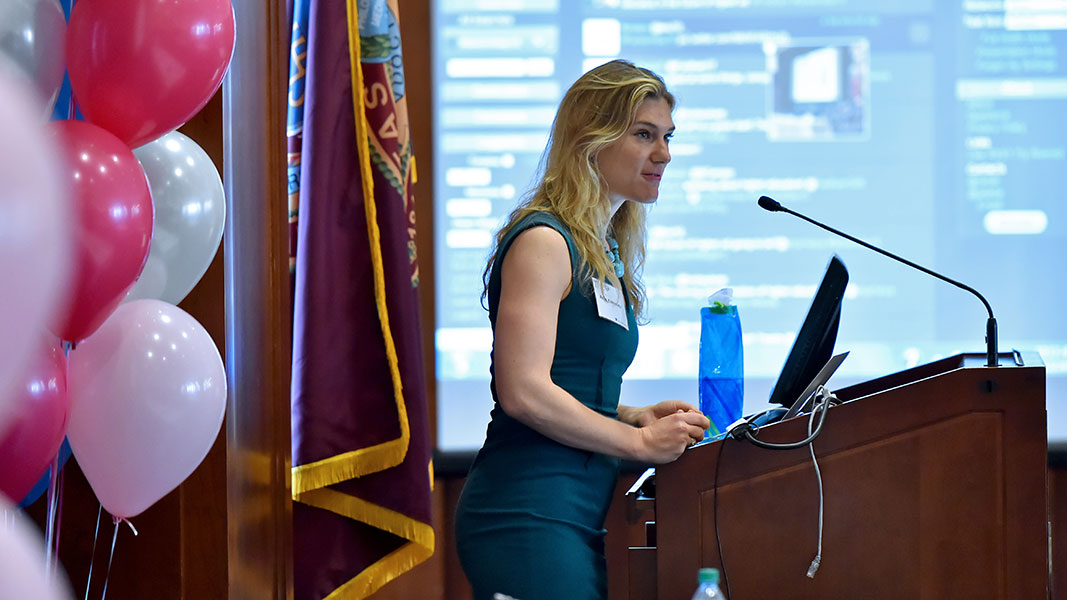
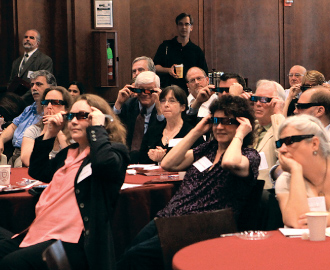
Photo by Tom Stoelker
Using terms like “artisanal data harvesting,” the Faculty Technology Day keynote speaker Ben Vershbow, manager of the New York Public Library (NYPL) Digital Improvement Group, guided a rapt audience through ways humans and computers can better collaborate. Fordham IT sponsored the May 21 event.
Vershbow delivered a mile-high perspective of digital possibilities for an august institution like the NYPL, a message that resonated with Fordham faculty wrestling with similar issues of how to engage a digital audience.
He described the NYPL as a 19th-century institution striving to remain relevant in the 21st century. With a world-class archival map collection that began being digitized in the last decade, the library is seeking to make the digital maps more dynamic and interactive.
Vershbow showed a digital image of a 19th-century map of Lower Manhattan that lives online. He then explained how that map can be rectified with contemporary maps using Google Earth through a NYPL-designed website, Map Warper. The 19th-century map sits on top of the contemporary map, and a transparency dial can fade the older map atop the new map.
The result shows how extraordinarily accurate the 19th-century maps were, as the streets resolve almost perfectly with their contemporary cousins.
Such newly combined maps have the potential to be used with other data, for example, the recently released 1940 Census. Maps can then yield much richer information, such as who lived where and what they did for a living.
“We’re trying to drop pins in time,” said Vershbow. “If we open up the data, we can get the community involved.”
Vershbow said that Map Warper is “a call to action,” to engage the public on the site to rectify maps for themselves. Once completed, the newly rectified maps are available for all to see, or to correct if there’s a mistake.
The NYPL has gone even further with crowd sourcing in other areas. Vershbow said the library has a collection of approximately 45,000 menus dating back to 1848. However, as the fonts on the menus vary greatly, optical character recognition software is not able to recognize all the “funky fonts.”
In response, the NYPL has set up a “What’s on the Menu” site and has invited the public to transcribe the menus.
In much the same way that Wikipedia asks its community to help with quality control, the NYPL calls on the public to check the veracity of its data, he said. This “artisanal data harvesting” can only be accomplished through human and computer cooperation. The quality control may not be perfect, but the people who delve into the site are a conscientious group.
While the letters of Percy Bysshe Shelley have their own hallowed room within the library, what’s one to do with Timothy Leary’s floppy discs if the information can’t be accessed?
Verhshbow expressed a concern for preserving “tomorrow’s past” which will include newer writings that will exist on the digital cloud. Media archeology labs are being developed at some universities, but New York City still lacks a preservation lab, he said.
He warned of an “information hole” that could develop should the academic communities rely on technology companies to preserve important information.
]]>To access mFordham, go to http://mobile.fordham.edu/ from the Web browser on your mobile device, or scan the QR code below.

Once there, mFordham will give you access to a wealth of information abut the University—anytime, anywhere, anyhow.
Topics include:
• events
• interactive maps;
• news;
• videos;
• athletics news, schedules and team rosters; and
• an e-mail directory of staff and faculty members.
mFordham is compatible with all mobile devices and will be available at the Apple App Store in the coming weeks.
Additional mobile offerings will follow later this fall from Fordham IT.

- Faculty Experts Database
- RSS Feeds
- Blogs
- Photo Gallery
- Audio Library
We’d like to thank Fordham IT, especially the Webgroup, and the staff of Marketing and Communications, for launching the eNewsroom in what has been a long and grueling week—the culmination of months of programming and design work.
We’d like to hear your thoughts on the eNewsroom: especially what features you’d like to see added in the future. You can comment here or write to us privately at:[email protected].
]]>It should have occurred to us to post a notice on the home page before we began the process. We hope to restore full functionality, as the IT folks say, soon.
]]>The daylong conference features a keynote speech on the Millennial Generation (students born between 1979 to 1994,) by Richard Sweeney, university librarian, New Jersey Institute of Technology, followed by a series of faculty and student panel discussions. Sweeney has conducted more than 35 nationwide focus groups on the rapidly changing technology user behaviors of millenials. His work has been the subject of articles in The Chronicle of Higher Education and the New Jersey Star Ledger. He is the former vice provost of information and library services at Polytechnic University, Brooklyn N.Y.
The conference will host concurrent afternoon sessions in various technology applications, including Blackboard and Competency Assessment in Distance Education (CADE).
For further information and a full schedule, contact the IT’s conference website, or e-mail[email protected] to register.
]]>